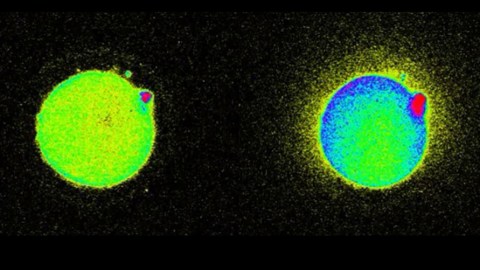Scientists Have Just Worked Out How to Find the Best Eggs for In Vitro

Image source: Northwestern
Scientists at Northwestern’s Feinberg School of Medicinehave just witnessed something amazing that happens when a sperm connects with an egg: Sparks literally fly. Zinc sparks. This electric event has been witnessed before in mice, but it’s the first time anyone’s seen and photographed it during human fertilization, and it could represent a significant advance in the success rate of in vitro fertilization.
The team injected an egg with sperm enzyme. (The use of actual sperm in experiments is illegal.) Doing this triggers an increase in calcium within the egg that then causes zinc to be released. The zinc binds to small molecule probes, that emit light that can be seen under a fluorescence microscope as a spark. From there, millions of zinc molecules explode momentarily all around the outside of the egg.
Being able to observe all this, and non-invasively, is important because zinc is critical for the development of a healthy embryo, and Northwestern has previously established that zinc is actually what triggers an embryo to grow and change into a distinct new organism, that is, a new person.
“This means if you can look at the zinc spark at the time of fertilization, you will know immediately which eggs are the good ones to transfer in in vitro fertilization (IVF),” according to Teresa Woodruff, one of the study’s two senior authors. “It’s a way of sorting egg quality in a way we’ve never been able to assess before.”
Study co-author Eve Feinberg adds, “There are no tools currently available that tell us if it’s a good quality egg. Often we don’t know whether the egg or embryo is truly viable until we see if a pregnancy ensues. That’s the reason this is so transformative. If we have the ability up front to see what is a good egg and what’s not, it will help us know which embryo to transfer, avoid a lot of heartache and achieve pregnancy much more quickly.”
The bottom line? Francesca Duncan, first author of the study and the person who first discovered the human zinc spark, says the breakthrough “will help us address one of the largest unanswered questions in reproductive medicine—what makes a good egg?”





